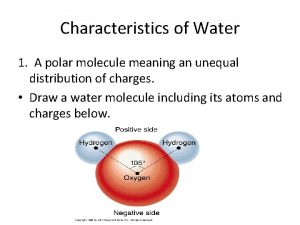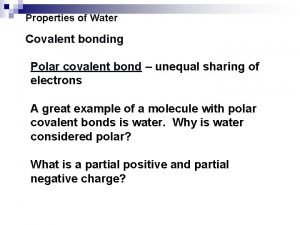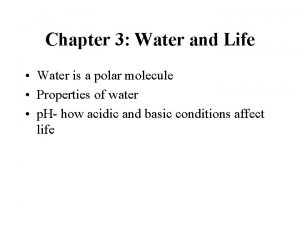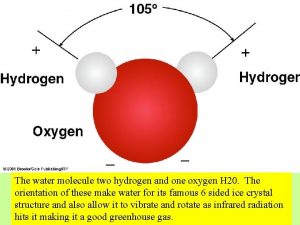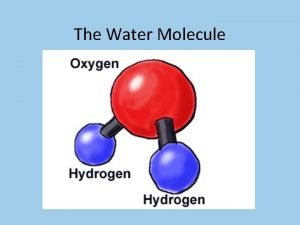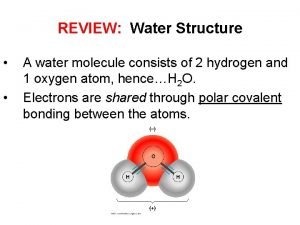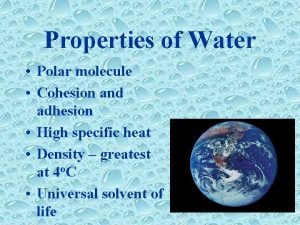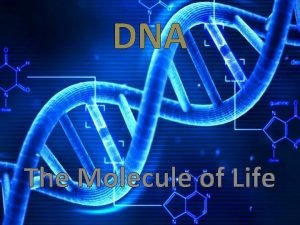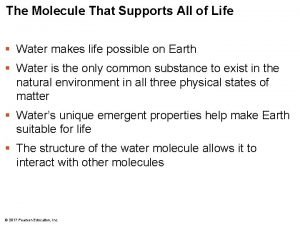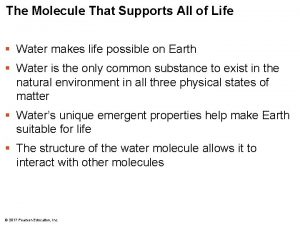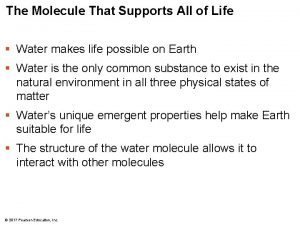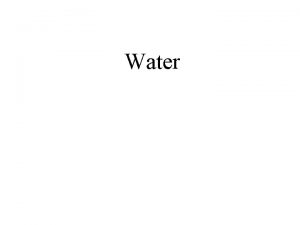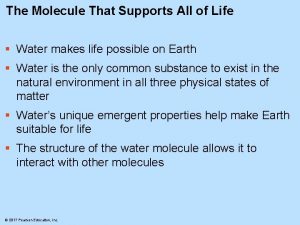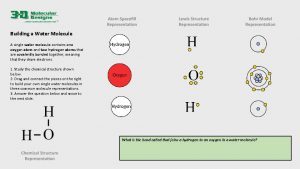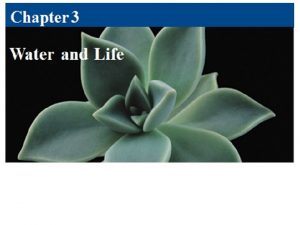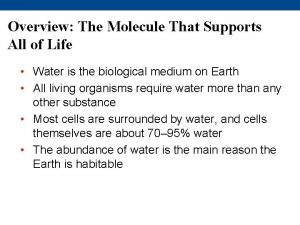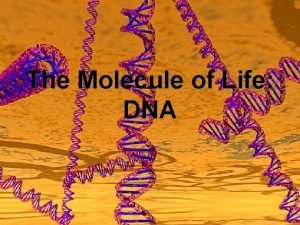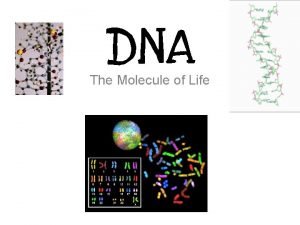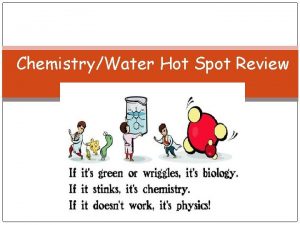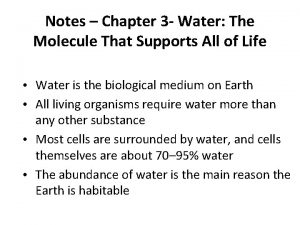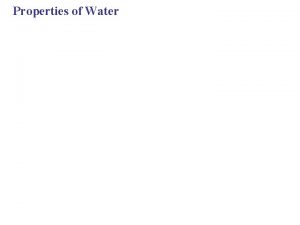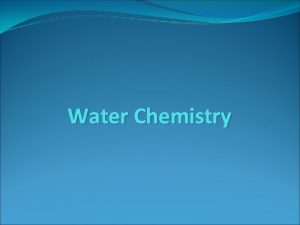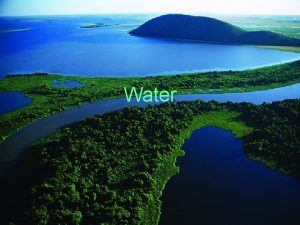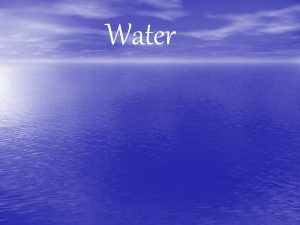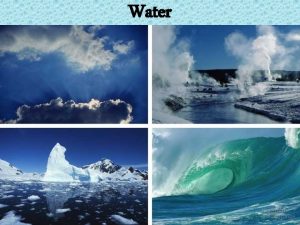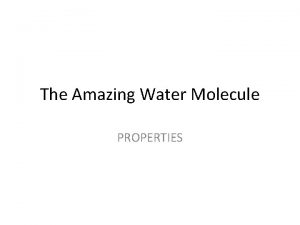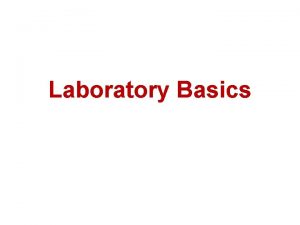The Molecule That Supports All of Life Water

































- Slides: 33

The Molecule That Supports All of Life § Water makes life possible on Earth § Water is the only common substance to exist in the natural environment in all three physical states of matter § Water’s unique emergent properties help make Earth suitable for life § The structure of the water molecule allows it to interact with other molecules © 2017 Pearson Education, Inc.

Water is essential to all life on Earth! § Water makes up about 70% of all living organisms on Earth (almost 90% of body weight!). This is some more evidence that life originated in water. Terrestrial organisms, like humans, have to carry their water with them. § Human brains are about 70% water. § Human lungs are nearly 90% water. § Human blood is about 83% water. To remain alive, an adult human must replace 2. 5 Liters of water/day. Much of this comes from foods that we eat. Humans’ sense of smell, taste and sight require water, and our alveoli, for gas exchange, always remain moist!

Properties of Water § the electrons of the polar covalent bonds spend more time near the oxygen than the hydrogen § polar molecule: overall charge is unevenly distributed § Polarity allows water molecules to form hydrogen bonds with each other © 2017 Pearson Education, Inc.

Properties of water § Cohesive behavior § Ability to moderate temperature § Expansion upon freezing - less dense as a solid than it is as a liquid – this is very rare on earth! § Versatility as a solvent § Water is “adhesive” © 2017 Pearson Education, Inc.

Cohesion of Water Molecules § the ability to bind to itself (surface tension) § Collectively, hydrogen bonds hold water molecules together, a phenomenon called cohesion § Cohesion helps the transport of water against gravity in plants § Adhesion is an attraction between different substances, for example, between water and plant cell walls © 2017 Pearson Education, Inc.

Figure 3. 3 Evaporation pulls water upward. H 2 O Adhesion Two types of water-conducting cells Direction of water movement H 2 O © 2017 Pearson Education, Inc. Cohesion 300 µm H 2 O

Animation: Water Transport in Plants © 2017 Pearson Education, Inc.

§ Surface tension is a measure of how difficult it is to break the surface of a liquid § Water has an unusually high surface tension due to hydrogen bonding between the molecules at the airwater interface and to the water below © 2017 Pearson Education, Inc.

Moderation of Temperature by Water § Water can absorb or release a large amount of heat with only a slight change in its own temperature § H 2 O resists changes in temperature § high specific heat § takes a lot to heat it up § takes a lot to cool it down § H 2 O moderates temperatures on Earth © 2017 Pearson Education, Inc.

§ Water’s high specific heat can be traced to hydrogen bonding § Heat is absorbed when hydrogen bonds break § Heat is released when hydrogen bonds form § The high specific heat of water minimizes temperature fluctuations to within limits that permit life © 2017 Pearson Education, Inc.

Evaporative Cooling Vaporization= liquid gas Heat of Vaporization= quantity of heat a liquid must absorb for 1 g to be converted to gaseous state(2260 J/g) Evaporative cooling = cooling of a liquid’s surface when the liquid evaporates *as large # of molecules break free and depart, they carry away some energy and decrease water’s surface temp. Water’s high heat of vaporization: 1. Moderates earth’s climate 2. Stabilizes temp. in aquatic ecosystems 3. Helps organisms from overheating by evaporative cooling

Evaporative Cooling § Evaporation (or vaporization) is transformation of a substance from liquid to gas § Heat of vaporization is the heat a liquid must absorb for 1 g to be converted to gas § As a liquid evaporates, its remaining surface cools, a process called evaporative cooling § Evaporative cooling of water helps stabilize temperatures in organisms and bodies of water © 2017 Pearson Education, Inc.

Floating of Ice on Liquid Water § Ice floats in liquid water because hydrogen bonds in ice are more “ordered, ” making ice less dense than water § Water reaches its greatest density at 4ºC § If ice sank, all bodies of water would eventually freeze solid, making life impossible on Earth © 2017 Pearson Education, Inc.

The special case of ice: Ice floats!! § Most substances are more dense when they are solid, but Not water…it is most dense at 4 C degrees § H bonds form a crystal and floats § If ice sank, all bodies of water would eventually freeze solid, making life impossible on Earth

Why is “ice floats” important? § Oceans & lakes don’t freeze solid § surface insulates water below § allowing life to survive the winter § if ice sank… § ponds, lakes & even oceans would freeze solid § in summer, only upper few inches would thaw § seasonal turnover of lakes § cycling nutrients in autumn


§ Many scientists are worried that global warming is having a profound effect on icy environments around the globe § The rate poses an extreme challenge to animals that depend on ice for their survival © 2017 Pearson Education, Inc.

Universal Solvent “like dissolves like” § Solution = a liquid that is a homogeneous mixture of 2 or more substances § Solvent = Dissolving agent of the solution § Solute = Substance dissolved in the solution § Aqueous = Solution in which water is the solvent Water is a medium for the chemical reactions of life~ METABOLISM

Water is the solvent of life § Polarity makes H 2 O a good solvent § polar H 2 O molecules surround + & – ions § solvents dissolve solutes creating solutions

§ Water can also dissolve compounds made of nonionic polar molecules § Even large polar molecules such as proteins can dissolve in water if they have ionic and polar regions © 2017 Pearson Education, Inc.

Hydrophilic and Hydrophobic Substances § A hydrophilic substance is one that has an affinity for water § A hydrophobic substance is one that does not have an affinity for water § Oil molecules are hydrophobic because they have relatively nonpolar bonds § Hydrophobic molecules related to oils are the major ingredients of cell membranes © 2017 Pearson Education, Inc.

Acids and bases § A hydrogen atom in a hydrogen bond between two water molecules can shift from one to the other § The hydrogen atom leaves its electron behind and is transferred as a proton, or hydrogen ion (H+) § The molecule that lost the proton is now a hydroxide ion (OH–) § The molecule with the extra proton is now a hydronium ion (H 3 O+), though it is often represented as H+ © 2017 Pearson Education, Inc.

§ Water is in a state of dynamic equilibrium in which water molecules dissociate at the same rate at which they are being reformed © 2017 Pearson Education, Inc.

§ Though statistically rare, the dissociation of water molecules has a great effect on organisms § Changes in concentrations of H+ and OH– can drastically affect the chemistry of a cell § Concentrations of H+ and OH– are equal in pure water § Adding certain solutes, called acids and bases, modifies the concentrations of H+ and OH– § Biologists use the p. H scale to describe whether a solution is acidic or basic (the opposite of acidic) © 2017 Pearson Education, Inc.

Acids and Bases § An acid is a substance that increases the H+ concentration of a solution § A base is a substance that reduces the H+ concentration of a solution § Strong acids and bases dissociate completely in water § Weak acids and bases reversibly release and accept back hydrogen ions, but can still shift the balance of H+ and OH– away from neutrality © 2017 Pearson Education, Inc.

2 Acids 6 and Bases

§ Acidic = p. H values less than 7 § Basic = values greater than 7 § Most biological fluids have p. H values in the range of 6 to 8 © 2017 Pearson Education, Inc.

2 Acids 8 and Bases Acid: a chemical that releases H+1 ions. Base: a chemical that accepts H+1 ions. Buffer: a chemical that accepts/releases H+1 as necessary to keep p. H constant

Buffers § The internal p. H of most living cells is close to 7 § Buffers are substances that minimize changes in concentrations of H+ and OH– in a solution § Most buffer solutions contain a weak acid and its corresponding base, which combine reversibly with H+ ions © 2017 Pearson Education, Inc.

Buffers in the BLOOD! If your blood has been depleted of water causing a rise in p. H (more hydroxide ions) of blood from normal 7. 4 How does equilibrium respond knowing a person cannot survive a shift in blood p. H of more than 10 -fold? More carbonic acid dissociates resulting in more H+ (producing more © 2017 Pearson Education, Inc. -

Acidification: A Threat to Our Oceans § Human activities such as burning fossil fuels threaten water quality § CO 2 is the main product of fossil fuel combustion § About 25% of human-generated CO 2 is absorbed by the oceans § CO 2 dissolved in seawater forms carbonic acid H 2 CO 3; this process is called ocean acidification © 2017 Pearson Education, Inc.

Figure 3. 12 As seawater acidifies, H+ ions combine with carbonate ions to produce bicarbonate HCO 3 Carbonate is required for calcification (production of calcium carbonate) by many marine organisms, including reef-building corals We have made progress in learning about the delicate chemical balances in oceans, lakes, and rivers © 2017 Pearson Education, Inc. CO 2 H 2 CO 3 CO 2 + H 2 O H 2 CO 3 H+ + HCO 3– H+ + CO 32– + Ca 2+ HCO 3– Ca. CO 3

§ As seawater acidifies, H+ ions combine with carbonate ions to produce bicarbonate HCO 3 § Carbonate is required for calcification (production of calcium carbonate) by many marine organisms, including reef-building corals § We have made progress in learning about the delicate chemical balances in oceans, lakes, and rivers © 2017 Pearson Education, Inc.
 Water and water and water water
Water and water and water water Ngoại tâm thu thất chùm đôi
Ngoại tâm thu thất chùm đôi Block nhĩ thất cao độ
Block nhĩ thất cao độ Thể thơ truyền thống
Thể thơ truyền thống Thơ thất ngôn tứ tuyệt đường luật
Thơ thất ngôn tứ tuyệt đường luật Chiến lược kinh doanh quốc tế của walmart
Chiến lược kinh doanh quốc tế của walmart Tìm vết của mặt phẳng
Tìm vết của mặt phẳng Con hãy đưa tay khi thấy người vấp ngã
Con hãy đưa tay khi thấy người vấp ngã Tôn thất thuyết là ai
Tôn thất thuyết là ai Gây tê cơ vuông thắt lưng
Gây tê cơ vuông thắt lưng Sau thất bại ở hồ điển triệt
Sau thất bại ở hồ điển triệt Water
Water Describe the polar characteristics of a water molecule.
Describe the polar characteristics of a water molecule. Water molecule
Water molecule Is water covalent
Is water covalent Polar covalent bond in water molecule
Polar covalent bond in water molecule Water molecule
Water molecule Water molecule
Water molecule Water molecule diagram
Water molecule diagram Polar molecule
Polar molecule Water is a polar molecule
Water is a polar molecule Geometry names chemistry
Geometry names chemistry Dna the molecule of life
Dna the molecule of life Name a point that is collinear with the given points
Name a point that is collinear with the given points Hình ảnh bộ gõ cơ thể búng tay
Hình ảnh bộ gõ cơ thể búng tay Frameset trong html5
Frameset trong html5 Bổ thể
Bổ thể Tỉ lệ cơ thể trẻ em
Tỉ lệ cơ thể trẻ em Chó sói
Chó sói Thang điểm glasgow
Thang điểm glasgow Chúa yêu trần thế
Chúa yêu trần thế Các môn thể thao bắt đầu bằng tiếng nhảy
Các môn thể thao bắt đầu bằng tiếng nhảy Thế nào là hệ số cao nhất
Thế nào là hệ số cao nhất Các châu lục và đại dương trên thế giới
Các châu lục và đại dương trên thế giới












